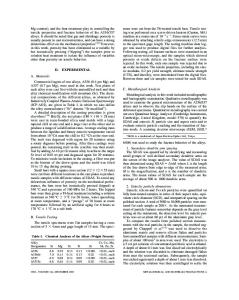Microstructural effects on high-cycle fatigue-crack initiation in A356.2 casting alloy
- PDF / 944,496 Bytes
- 8 Pages / 612 x 792 pts (letter) Page_size
- 36 Downloads / 354 Views
I. INTRODUCTION
THE mechanical properties of widely used A356.2 aluminum castings have been related to microstructural features such as secondary dendrite arm spacing (SDAS),[1,2,3] microporosity,[4,5,6] intermetallics,[7] and eutectic silicon particles[8,9] and to variations in heat treatment[10,11] since the late 1940s. Although the study of the relationship between fatigue properties and microstructures in A356 can be dated back to the 1950s,[12] it has been only recently that there has been a concerted impetus to use more aluminum castings in automobiles[13,14] to achieve weight reduction and corresponding improvements in fuel economy and emissions. As sound commercial aluminum castings find more applications, more information on the effects of microstructures on fatigue properties would enhance both the practical improvement of the current casting processing and the fundamental understanding of fatigue processes in aluminum casting alloys. It is generally accepted that the fatigue process consists mainly of four important stages: microcrack initiation, microcrack coalescence and growth (small-crack propagation), macrocrack growth, and final fracture. From the point view of fatigue life, the crack propagation dominates the low-cycle fatigue (LCF) life, and crack initiation controls the high-cycle fatigue (HCF) life. Fatigue cracks in aluminum alloys have been found to initiate from slip bands, constituent particle breakage and debonding, and grainboundary separation.[15] In hypoeutectic Al-Si casting alloys, fatigue cracks usually initiate from shrinkage pores at or close to the specimen surface,[16–23] often associated with a small crack-initiation period.[23] However, research has been focused on fatigue-crack propagation of long cracks using linearly elastic fracture-mechanics methods. Much more B. ZHANG, Graduate Research Assistant, and D.R. POIRIER, Professor, Department of Materials Science and Engineering, and W. CHEN, Assistant Professor, Department of Aerospace and Mechanical Engineering, are with The University of Arizona, Tucson, AZ 85721. Manuscript submitted December 29, 1998. METALLURGICAL AND MATERIALS TRANSACTIONS A
research on small-crack propagation[24] in commercial aluminum castings is needed to better reveal the interaction of microstructures with the fatigue process. In this study, we investigated microstructural effects on HCF crack initiation and the interaction of microstructure with the propagation of fatigue cracks during HCF in A356.2 specimens removed from a casting ingot with gradients in SDAS and porosity. In related work,[25] the fatigue lives of the specimens are given for both LCF and HCF conditions, without the level of detail on microconstituents presented here. II. EXPERIMENTAL PROCEDURES A. Materials and Fatigue Testing The A356.2 casting ingots were solidified with bottomwater cooling to effect a gradient in SDAS. The melt was degassed with Ar, grain refined with an Al-3Ti-1B master alloy, and modified with an Al-15Sr alloy. The composition (in wt pct) was 6.87 Si, 0.36
Data Loading...











